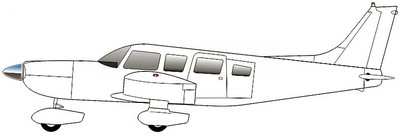Thu, Dec 07, 2023
Observed The Accident Airplane Flying South, Before It Began A Left Circling Turn With A “White Mist” Trailing The Airplane
Location: Marion, OH Accident Number: ERA24FA026
Date & Time: October 31, 2023, 11:23 Local Registration: N44601
Aircraft: Piper PA-32-300 Injuries: 2 Fatal
Flight Conducted Under: Part 91: General aviation - Personal

On October 31, 2023, at 1123 eastern daylight time, a Piper PA32-300, N44601, was destroyed when it was involved in an accident near Marion, Ohio. The pilot and pilot-rated passenger were fatally injured. The airplane was operated as a Title 14 Code of Federal Regulations Part 91 personal flight.
A witness stated that he was standing outside his house when he heard an airplane flying in the distance and the engine sounded like it was “oscillating.’ He looked up and observed the accident airplane flying south, before it began a left circling turn with a “white mist” trailing the airplane. He further stated that the engine “cut out” and the airplane went “nose down” and impacted the ground.
A residential video doorbell recorded the sound of the airplane prior to the accident. The engine sound was constant and consistent with a high rpm setting.
The wreckage was located in an open field, about a 1/2 mile from a county road. The airplane impacted the ground in a steep nose down, nearly vertical attitude. The magnetic heading was 090°. The engine and propeller were buried about 2 feet in the ground. A postimpact fire destroyed most of the airframe. The left wing displayed accordion crushing along the entire leading edge. Flight control continuity was observed to all primary flight controls through frayed cables and fractured bell cranks.

The propeller hub was fragmented and separated from the engine flange. The engine intake and exhaust pipes were crushed and separated. The Nos. 2, 3 and 4 cylinders were impact damaged. The No. 1 cylinder head and valves were impact damaged. The No. 2 cylinder head was separated from the barrel and impact fragmented. The barrel remained attached to the engine crankcase. The No. 3 cylinder head and valves were impact damaged. The No. 4 cylinder, connecting rod and piston were separated from the crankcase. A portion of the cylinder barrel flange and barrel remained attached to the crankcase. One connecting rod bolt was separated from the connecting rod and not observed. The rod was impact damaged. The No. 4 crankshaft rod journal was undamaged. No thermal discoloration or scoring of the journal surface was observed. The engine crankshaft could not be rotated by turning the propeller flange. The interiors of the cylinders, which remained attached to the engine were observed using a lighted borescope and
no anomalies were noted. Oil was observed in the engine. The oil suction screen contained ferrous metallic debris that was forwarded to the National Transportation Safety Board Materials Laboratory for further examination.
The wreckage was retained for further examination.
More News
Circle To Runway (Runway Number) Used by ATC to inform the pilot that he/she must circle to land because the runway in use is other than the runway aligned with the instrument appr>[...]
Aero Linx: National Aviation Safety Foundation (NASF) The National Aviation Safety Foundation is a support group whose objective is to enhance aviation safety through educational p>[...]
At Altitude Of About 250-300 Ft Agl, The Airplane Experienced A Total Loss Of Engine Power On November 6, 2024, at 1600 central standard time, a De Havilland DHC-1, N420TD, was inv>[...]
From 2009 (YouTube Edition): Three Hour Flight Was 'Flawless' -- At Least, Until Mother Nature Intervened For anyone who loves the aviation business, this was a VERY good day. Afte>[...]
Also: AMA Names Tyler Dobbs, More Falcon 9 Ops, Firefly Launch Unsuccessful, Autonomous F-16s The Air Force has begun ground testing a future uncrewed jet design in a milestone tow>[...]
 ANN's Daily Aero-Term (05.05.25): Circle To Runway (Runway Number)
ANN's Daily Aero-Term (05.05.25): Circle To Runway (Runway Number) ANN's Daily Aero-Linx (05.05.25)
ANN's Daily Aero-Linx (05.05.25) NTSB Prelim: De Havilland DHC-1
NTSB Prelim: De Havilland DHC-1 Classic Aero-TV: The Boeing Dreamliner -- Historic First Flight Coverage
Classic Aero-TV: The Boeing Dreamliner -- Historic First Flight Coverage Airborne-NextGen 05.06.25: AF Uncrewed Fighters, Drones v Planes, Joby Crew Test
Airborne-NextGen 05.06.25: AF Uncrewed Fighters, Drones v Planes, Joby Crew Test




